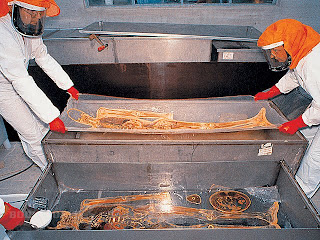Although MOSI is primarily a science center, we do have fairly regular art installations by artisans who create pieces that are a blend of art and science. Currently, one of these art exhibitions is a collection of quilts by Elaine Ellison who creates quilts that have mathematics at the core of their design concepts. The  artist finds inspiration in mathematical sequences, architecture, and mathematics that occurs in nature.
artist finds inspiration in mathematical sequences, architecture, and mathematics that occurs in nature.
Chartres Cathedral Quilt: "Chartres Cathedral labyrinth is an approximate golden rectangle. The gothic cathedral, begun in 1145, has a labyrinth on its’ floor. The cathedral marks the high point of French Gothic art. Pilgrims walk the labyrinth in reflection of their lives. A labyrinth has only one path. The architect of this cathedral is unknown.” –Elaine Ellison’s website
Buckeyballs and Bubbles - “This quilt turned out to be a tribute to Richard Smalley, a professor who discovered the existence of the Buckeyball in soot. For centuries it was thought that the only two pure forms of carbon were hard sparkling diamonds and dull, slippery graphite. In l985, Smalley's team announce a third pure form of carbon C-60. The Buckeyball was named after Buckminster Fuller, the inventor of the geodesic dome. The symmetry in the Buckeyball lends itself to applications in drug design, chemical sponges, miniature circuits, lubricants, catalysts, chemical probes in a scanning-fo rce microscope, batteries, molecular sieves, and possible use in photo copiers.” –Elaine Ellison’s website
to Richard Smalley, a professor who discovered the existence of the Buckeyball in soot. For centuries it was thought that the only two pure forms of carbon were hard sparkling diamonds and dull, slippery graphite. In l985, Smalley's team announce a third pure form of carbon C-60. The Buckeyball was named after Buckminster Fuller, the inventor of the geodesic dome. The symmetry in the Buckeyball lends itself to applications in drug design, chemical sponges, miniature circuits, lubricants, catalysts, chemical probes in a scanning-fo rce microscope, batteries, molecular sieves, and possible use in photo copiers.” –Elaine Ellison’s website
About the Artist: Elaine Ellison, mathematical quilting artist
 As the daughter of creative parents, I was fortunate to explore a variety of media from a very young age. My parents taught me the value of the arts in everyday life. Between my parents and the Central Michigan University Art Department, I was fortunate to explore drawing, painting, bronze work, photographs, woodworking, and textiles. My devotion to cloth peaked in the early l980’s when I read the book Geometry and the Visual Arts by Dan Pedoe. From this time, I have continued to explore the way that cloth can help me express mathematics geometrically.
As the daughter of creative parents, I was fortunate to explore a variety of media from a very young age. My parents taught me the value of the arts in everyday life. Between my parents and the Central Michigan University Art Department, I was fortunate to explore drawing, painting, bronze work, photographs, woodworking, and textiles. My devotion to cloth peaked in the early l980’s when I read the book Geometry and the Visual Arts by Dan Pedoe. From this time, I have continued to explore the way that cloth can help me express mathematics geometrically.
My retirement from formal teaching in 2005 has given me time to develop more mathematical quilts. I continue to speak around the world at mathematics conferences, art museums, quilt groups and general interest groups. I have developed a wonderful PowerPoint presentation of my mathematical quilts that I share with interested groups.
Visit MOSI to see a beautiful collection of mathematical quilts on display in the 2nd floor connecting corridor gallery. You can also visit the artist’s website to learn more about Elaine and her work.















 Liquids: One liquid forms the slow moving blobs, like in the picture, we will call this
Liquids: One liquid forms the slow moving blobs, like in the picture, we will call this 











